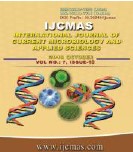


 National Academy of Agricultural Sciences (NAAS)
National Academy of Agricultural Sciences (NAAS)

|
PRINT ISSN : 2319-7692
Online ISSN : 2319-7706 Issues : 12 per year Publisher : Excellent Publishers Email : editorijcmas@gmail.com / submit@ijcmas.com Editor-in-chief: Dr.M.Prakash Index Copernicus ICV 2018: 95.39 NAAS RATING 2020: 5.38 |
Seed drill is a sowing device that precisely positions seeds in the soil and then covers them. Before the introduction of the seed drill, the common practice was to plant seeds by hand. Planting density is one of the main factors that have an important role on growth, yield and quality of groundnut. It is important to accommodate the most appropriate number of plants per unit area of land to obtain better yield. Scientists in DAATT Centre, Vizianagaram District of ANGRAU in collaboration with Department of Agriculture, Vizianagaram District has tested the feasibility of sowing of Groundnut with Ferti Cum Seed Drill technology with comparing normal sowing method of cultivation through organizing On-Farm Trial (OFT) during Kharif, 2015 and Kharif,2016 in 3 locations each. Sowing with seed drill observed 33 of plants/sq.mt in comparison with farmer’s practice 23 of plants/sq.mt with 43.47% of reduction plant population. In ferti cum seed drill plots 30.33% more number of pods(23 pods/plant) recorded when compared to farmers practice(18 pods/plant). Pod yield increase was achieved to a tune of 15.62% in sowing of groundnut with Ferti Cum Seed Drill method (1121 kgha-1) over normal method of cultivation (970 kgha-1). The gross income (Rs.56075 ha-1) was recorded 15.62% more in Ferti cum seed drill plots in comparison with farmers practice. The net returns also recorded 64.86% higher in Ferti cum Seed drill sown plots along with reduction of 7.93% reduction of cost of cultivation realized over normal sowing method. It was observed that the benefit cost ratio was higher in sowing of groundnut with Ferti cum Seed drill (1.60) which is higher than in conventional method(1.27). Increases in crop yield and crop returns depend on the uniform and timely establishment of optimum plant population.
 |
 |
 |
 |
 |